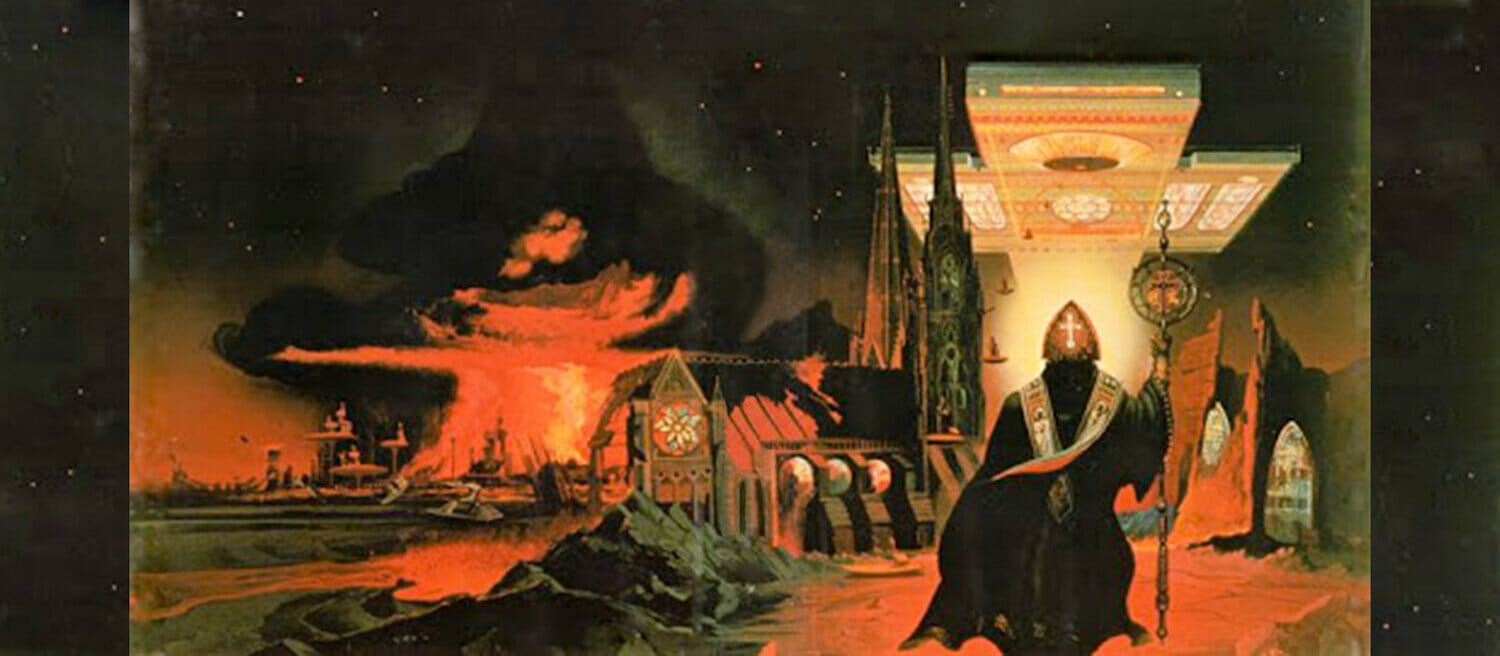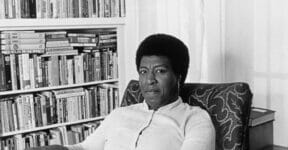Many sci-fi novels are outright imaginary, some others are alternative history, and a few are inspired by the author’s own experiences. A Canticle for Leibowitz (1959), written by Walter M. Miller Jr., falls under the third category. The post-apocalyptic social science fiction novel has a three-part structure. Each part is separated by a period of six centuries. The basic premise is the demise of scientific knowledge in the aftermath of a nuclear war. The surviving civilization thinks of science as a dangerous tool and aggressively bans books of any sort. Anybody who is caught reading or learning about anything is likely to get killed.

A Canticle of Leibowitz is the story of a group of monks in their attempt to preserve books, knowledge, and information from and about the time before the war.
Author’s Background
To know a bit more about the author’s background, or specifically his reasoning behind the decision to write the novel in the first place, it takes a revisit to a history lesson about The Battle of Monte Cassino during World War 2 between the Allied forces and Nazi Germany at Cassino, Italy from January 17 to May 18, 1944.
Situated at the top of the rocky Monte Cassino hill (about 80 miles south of Rome) was an abbey established by St. Benedict of Nursia in 529. When World War II started, the monastery had already become a repository of tens of thousands of old manuscripts, including the majority of writings by Horace, Cicero, and Virgil.
The monastery happened to be sitting at a crucial section of the Gustav Line, a line of fortified defenses stretching across the Italian peninsula that blocked the Allied forces from marching to Rome. The center of the Gustav Line crossed the main route north to the capital and was anchored around the hills and mountains near Cassino. Based on ambiguous intel that Nazi Germany was using the monastery as a garrison, the Allied command made the order to bomb away Monte Cassino.
On February 15, 1944, a barrage of American B-17s, B-25s, and B26s dropped more than 400 tons of explosives on the monastery, destroying it to ruins. Nazi Germany, seeing it as fodder for propaganda, began to spread the message of how the Americans had no hesitation to destroy a religious institution. Luckily, many of the manuscripts had been relocated to Rome before the bombardment started, however.

Among the American airmen who took part in the bombardment of Monte Cassino was a tail gunner named Walter M. Miller Jr. from Florida. He enlisted in the Army shortly after the Pearl Harbor attack and continued to fly on more than 50 missions in B-25 above the Balkans and the Mediterranean. After the war, Miller studied engineering at the University of Texas and converted to Catholicism.
Miller started to publish novellas and short stories in the 1950s. In fact, his 1955 work The Darfsteller won the first Hugo Award for Best Novelette. He also wrote scripts for Captain Video and His Video Rangers television show alongside such big names as Arthur C. Clarke and Isaac Asimov. The only novel Miller published in his lifetime was A Canticle for Leibowitz, for which he would always be fondly remembered in the literary world.
Major Themes
The novel is actually comprised of three novellas: Fiat Homo, Fiat Lux, and Fiat Voluntas Tua, originally written as short stories published from 1955 – 1957 in The Magazine of Fantasy & Science Fiction. A fix-up of those pieces became A Canticle for Leibowitz, published for the first time in October 1959.
Fiat Homo (Let There Be Man)
Events in Fiat Homo are set some 600 years after the nuclear war, subsequently known as the Flame Deluge. The new era after the war is marked by a growing hatred toward science, seen by the general public as the harbinger of nuclear weapons. In a process called the “Simplification,” no one is allowed to read and study science. Among the angriest proponents of the process are the “Simpletons,” violent mobs always at the ready to execute anybody who opposes their ideas. Most people end up being illiterate.
Despite the threats, the monks at a monastery in a Utah desert are determined to safeguard all the remaining scientific knowledge to honor the memory of Isaac Edward Leibowitz, a martyred denouncer of Simplification. The monks keep records of the “Leibowitz Memorabilia” consisting of documents, circuit diagrams, and even shopping lists.
Fiat Lux (Let There Be Light)
About a thousand years after Flame Deluge, human civilization is on the verge of coming out of the dark age. A scientist named Thon Taddeo gives the monastery a visit and finds himself perplexed by the invention of an electric light powered by a treadmill of some sort. Taddeo wants to take and use some items from the library, but the abbot denies his request.
Fiat Voluntas Tua (Let Thy Will Be Done)
The year is 3781, and human civilization has surpassed the scientific development of the pre-war era. Space travels are commonplace. Even the monastery has a communication device that seems to be inspired by Star Trek. With all the technologies, the world is once again on the brink of another nuclear war fought between two dominant powers: the Asian Coalition and the Atlantic Confederacy. As the conflicts begin, the abbot orders a group of monks to take the Leibowitz Memorabilia to a colony in Alpha Centauri. An atomic bomb then reduces the 2000-year-old monastery to ruins.
It is impossible to overstate the thought-provoking aspect of A Canticle for Leibowitz. For every problem the novel raises, it barely offers a clear-cut solution but only more questions to ponder. Published in the late 1950s, just about every point is as relevant as it has always been today; not only about the nuclear threats but the cyclic nature of history itself.
Have you read A Canticle for Leibowitz? Do you think the novel deserves the acolades in social science fiction, or is it nothing but a shallow fantasy? We’d love to hear from you.
Other things you might want to know:
What is social science fiction?
According to Isaac Asimov, who originally coined the term in 1953, social science fiction represents a broad category of narratives depicting how society is affected by scientific advances and new technologies. One of the most common characteristics of social sci-fi is that the genre rarely, if ever, delves into the “hard” science and instead focuses on changes in society.
What are some well-known popular social science fiction novels?7
A few major highlights of the subgenre:
- Octavia E. Butler – Parable of the Sower
- Ray Bradbury – Fahrenheit 451
- Yevgeny Zamyatin – We
- Isaac Asimov – The Foundation series
Books and short stories written by Walter M. Miller Jr. include:
- Conditionally Human (1962)
- The View from the Stars (1965)
- The Science Fiction Stories of Walter M. Miller Jr. (1977)
- The Best of Walter M. Miller Jr. (1980)
- Conditionally Human and Other Stories (1982)
- The Darfstellar and Other Stories (1982)
Check out other articles by month:







